For Parents - Educational Programs For Hearing Impairment
A unique feature of hearing loss or deafness is that it is ‘invisible’ unlike all other disabilities, which are visible to the eyes.
Hearing impairment is felt only when an interaction takes place between two persons and one of them is not able to communicate with the other like two normal persons.
- Simply put, hearing impairment is the inability of a child or person to listen to sounds
- This could be congenital (i.e. by birth), pre-lingual, or post lingual (i.e. before or after gaining speech and language)
- Congenital loss could be due to the consumption of toxic drugs, occurrence of diseases like jaundice or german measles, premature birth, heredity, or even illness during pregnancy, among other possible causes
- Post lingual loss could be due to accidents, illness, old age, consumption of drugs etc.
Early Detection & Action
Though India as a country has been successful in lowering mortality rates, the burden of disability has not come down, in fact, it has risen over the years. Many disabilities can be avoided if we have a proper screening program. (Garg S, Infant Hearing Screening In India: Current Status And Way Forward, 2015)
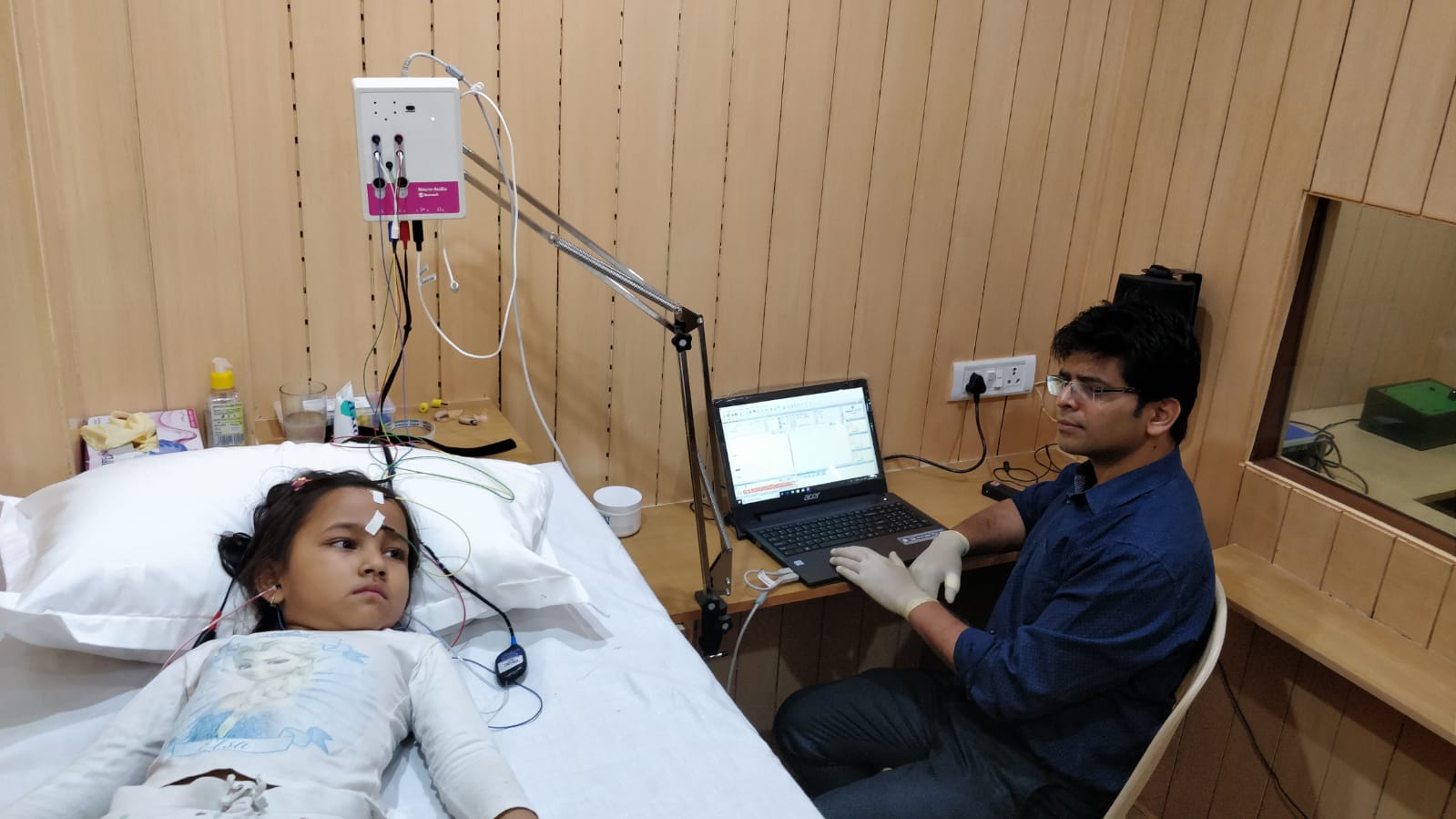
- Out of every 1,000 children born in India, there may be 5-6 who cannot hear properly
- Since there are no visual indicators, most hearing impaired children are not identified until between 1.5 and 3 years of age
- At this age we see healthy speech and language development in most children
- However, with the help of new born hearing screening, a hearing impaired child can be identified and treated early.
- In such a case, the child will most likely develop language, speech, and social skills comparable to his or her normal-hearing peers, and thus avoid a lifetime of hearing loss related disabilities
Hearing Aids & Cochlear Implants
A hearing aid is a device designed to improve hearing by making sound audible to a person with hearing loss. Hearing aids are used for a variety of pathologies including sensorineural hearing loss, conductive hearing loss, and single-sided deafness. We take care of it at our educational program for hearing impairment.
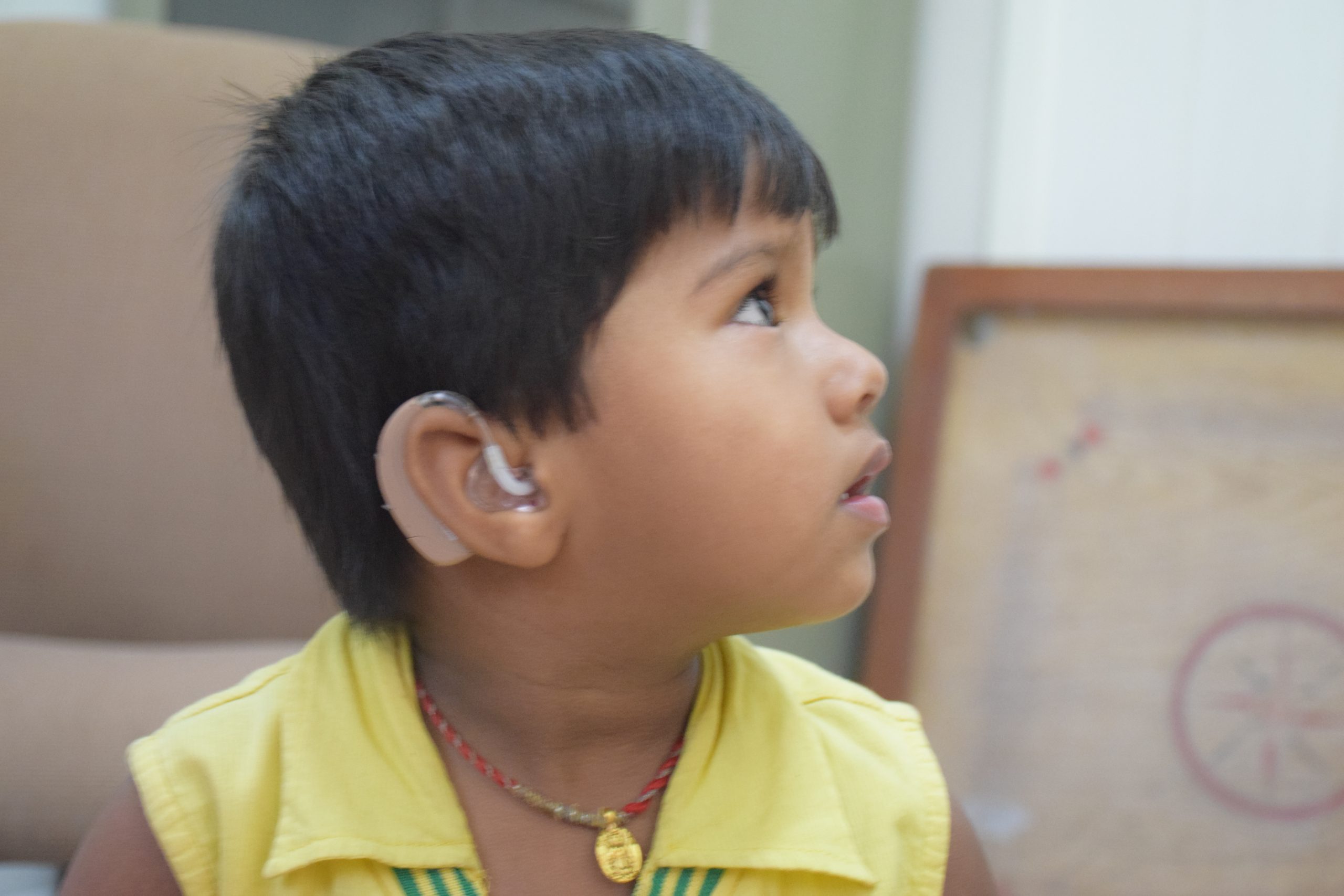
Hearing aid candidacy is typically determined by a Doctor of Audiology, who will also fit the device based on the nature and degree of the hearing loss being treated. The amount of benefit experienced by the user of the hearing aid is multi-factorial, depending on the type, severity, and etiology of the hearing loss, the technology and fitting of the device, and on the motivation, personality, lifestyle, and overall health of the user.
Hearing aids are an aid to make sounds more audible. The most common form of hearing loss for which hearing aids are sought is sensorineural, resulting from damage to the hair cells and synapses of the cochlea and auditory nerve. Sensorineural hearing loss reduces the sensitivity to sound, which a hearing aid can partially accommodate by making sound louder. Other problems caused by sensorineural hearing loss, such as abnormal spectral and temporal processing, are more difficult to compensate for using digital signal processing and in some cases may be exacerbated using amplification.
Conductive hearing losses, which do not involve damage to the cochlea, tend to be better treated by hearing aids; the hearing aid is able to sufficiently amplify sound to account for the attenuation caused by the conductive component. Once the sound reaches the cochlea at normal or near-normal levels, the cochlea and auditory nerve can transmit signals to the brain normally.
Common issues with hearing aid fitting and use are the occlusion effect, loudness recruitment, and understanding speech in noise. Once a common problem, feedback is generally now well-controlled using feedback management algorithms.
At our educational program for hearing imparment the target recipients of Suniye in the centre stage are children. The organisation believes that a child’s education cannot be achieved without addressing the needs of the chilren, particularly the parents, as well as the communities in which they live. Contact us for free audiometry test from Suniye’s best audiologists in Delhi
Types of Hearing Aids and their use
BTE hearing aids consist of a case which hangs behind the pinna, the rear part of the ear. The case is attached to an earmold or dome tip by a traditional tube, slim tube, or wire. The tube or wire courses from the superior-ventral portion of the pinna to the concha, where the ear mould or dome tip inserts into the external auditory canal. The case contains the electronics, controls, battery, and microphone(s). The loudspeaker, or receiver, may be housed in the case (traditional BTE) or in the ear mould or dome tip (receiver-in-the-canal, or RIC). The RIC style of BTE hearing aid is often smaller than a traditional BTE and more commonly used in more active populations
BTEs are generally capable of providing more output and may therefore be indicated for more severe degrees of hearing loss. However, BTEs are very versatile and can be used for nearly any kind of hearing loss. BTEs come in a variety of sizes, ranging from the small ‘mini BTE’, to larger ultra-power devices. Size typically depends on the output level needed, the location of the receiver, and the presence or absence of a telecoil. BTEs are durable, easy to repair, and often have controls and battery doors that are easier to manipulate. BTEs are also easily connected to assistive listening devices, such as FM systems and induction loops. BTEs are commonly worn by children who need a durable type of hearing aid.
In-The-Ear Hearing Aids (ITE) devices fit in the outer ear bowl (called the concha). Being larger, these are easier to insert and can hold extra features. They are sometimes visible when standing face to face with someone. ITE hearing aids are custom made to fit the individual’s ear. They can be used in mild to some severe hearing losses. Feedback, a squealing/whistling caused by sound (particularly high frequency sound) leaking and being amplified again, may be a problem for severe hearing losses. Some modern circuits can provide feedback regulation or cancellation to assist with this. Venting may also cause feedback. A vent is a tube primarily placed to offer pressure equalization. However, different vent styles and sizes can be used to influence and prevent feedback.
Traditionally, ITEs have not been recommended for young children because their fit could not be as easily modified as the ear mould for a BTE, and thus the aid had to be replaced frequently as the child grew. However, there are new ITEs made from a silicone type material that mitigates the need for costly replacements. ITE hearing aids can be connected wirelessly to FM systems, for instance with a body-worn FM receiver with induction neck-loop which transmits the audio signal from the FM transmitter inductively to the telecoil inside the hearing instrument.
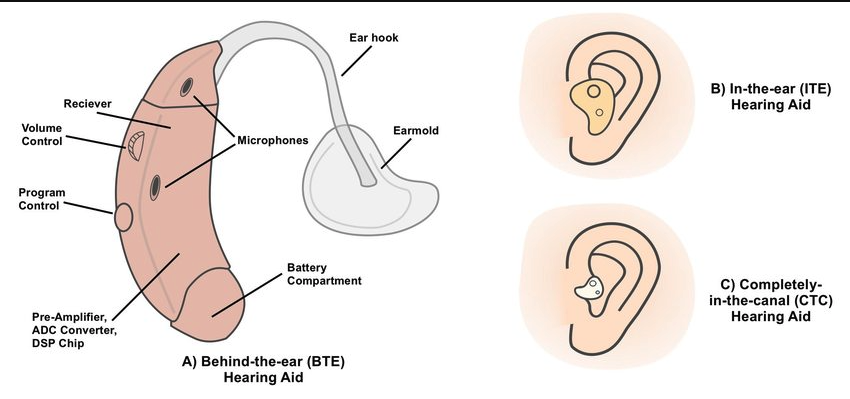
Cochlear Implant (CI)
A cochlear implant (CI) is a surgically implanted neuro-prosthesis that provides a person with sensorineural hearing loss a modified sense of sound. Cochlear implants bypass the normal acoustic hearing process to replace it with electric signals which directly stimulate the auditory nerve. A person with a cochlear implant receiving intensive auditory training may learn to interpret those signals as sound and speech. However, one-third of hearing impaired children do not develop language if they are on a cochlear implant program alone and have no sign language input
Program for Parent Understanding
Suniye provides quality education with educational programs for hearing impairment. We at Suniye believe that education is the foundation for all future possibilities in a student’s life. The school provides this educational atmosphere by serving as a sculpture and focusing on accomplishments and moral strength in managing one’s life.
Being a school for the hearing impaired we understand the value of education as it is a lengthy process and contains information, development, and transformation that does not happen overnight or in a vacuum. As a result, an educational institution creates an environment that upholds an uncompromising value system and brilliance. It develops a conscience and sound mind, capable of distinguishing right from wrong and making the best decision. It creates an empathetic heart capable of reaching out to our country’s less privileged.
Suniye has been working for hearing-impaired children to provide them all the facilities while also upholding all the laws for children rights in India, in order to give them what they deserve and to help them recognize their own strengths and capabilities. We as NGO for hearing impaired help students learn speech therapy language. Students are provided sufficient opportunities to integrate with society as part of their overall development. Exposure trips to other schools and participation in various programs with other students are quite beneficial in motivating them to study.
This school will continue to be a prime example of educational excellence as well as authentic personality development. It helps educate not only the mind but also the heart, inculcates not only quality but also ethical values, teaching to not just be successful but also to be humane and empathetic, and having to learn not just to be efficient but also effective.
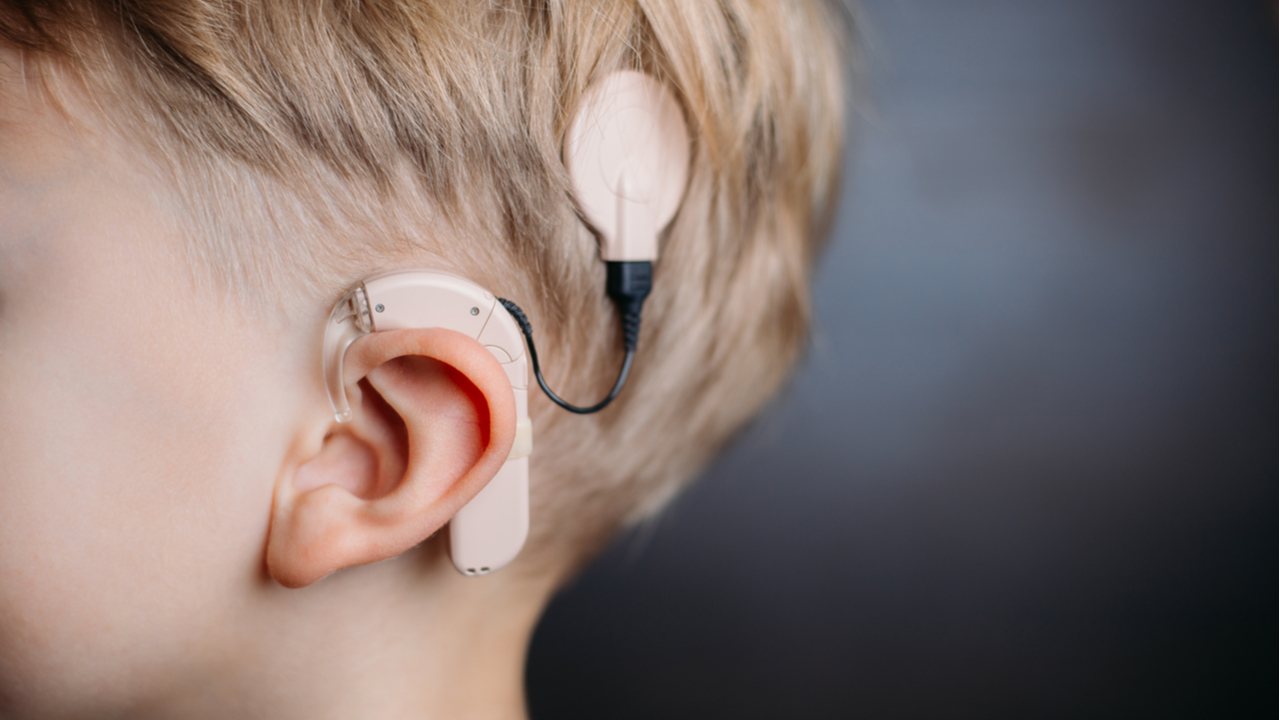
From the early days of implants in the 1970s and the 1980s, speech perception via an implant has steadily increased. Many users of modern implants gain reasonable to good hearing and speech perception skills post-implantation, especially when combined with lip reading. However, for pre-lingually deaf children the risk of not acquiring spoken language even with an implant may be 30% or more.
The implant has two main components. The outside component is generally worn behind the ear, but could also be attached to clothing, for example, in young children. This component, the sound processor, contains microphones, electronics that include digital signal processor (DSP) chips, battery, and a coil that transmits a signal to the implant across the skin. The inside component, the actual implant, has a coil to receive signals, electronics, and an array of electrodes which is placed into the cochlea, which stimulate the cochlear nerve. The surgical procedure is performed under general anaesthesia
 One of the challenges that remain with these implants is that hearing and speech understanding skills after implantation show a wide range of variation across individual implant users. Factors such as duration and cause of hearing loss, how the implant is situated in the cochlea, the overall health of the cochlear nerve, but also individual capabilities of re-learning are considered to contribute to this variation, yet no certain predictive factors are known.
One of the challenges that remain with these implants is that hearing and speech understanding skills after implantation show a wide range of variation across individual implant users. Factors such as duration and cause of hearing loss, how the implant is situated in the cochlea, the overall health of the cochlear nerve, but also individual capabilities of re-learning are considered to contribute to this variation, yet no certain predictive factors are known.
What should parents & families do?
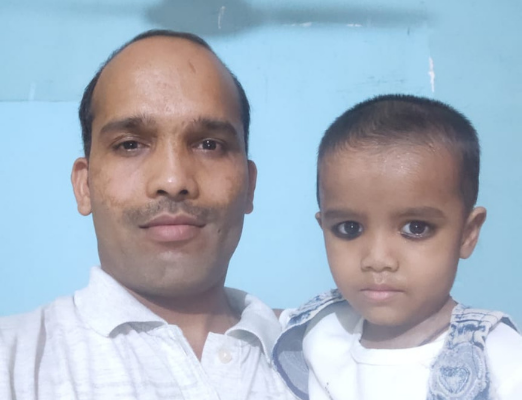
Hearing aid candidacy is typically determined by a Doctor of Audiology, who will also fit the device based on the nature and degree of the hearing loss being treated. The amount of benefit experienced by the user of the hearing aid is multi-factorial, depending on the type, severity, and etiology of the hearing loss, the technology and fitting of the device, and on the motivation, personality, lifestyle, and overall health of the user.
Hearing aids are an aid to make sounds more audible. The most common form of hearing loss for which hearing aids are sought is sensorineural, resulting from damage to the hair cells and synapses of the cochlea and auditory nerve. Sensorineural hearing loss reduces the sensitivity to sound, which a hearing aid can partially accommodate by making sound louder. Other problems caused by sensorineural hearing loss, such as abnormal spectral and temporal processing, are more difficult to compensate for using digital signal processing and in some cases may be exacerbated using amplification.
Conductive hearing losses, which do not involve damage to the cochlea, tend to be better treated by hearing aids; the hearing aid is able to sufficiently amplify sound to account for the attenuation caused by the conductive component. Once the sound reaches the cochlea at normal or near-normal levels, the cochlea and auditory nerve can transmit signals to the brain normally.
Common issues with hearing aid fitting and use are the occlusion effect, loudness recruitment, and understanding speech in noise. Once a common problem, feedback is generally now well-controlled using feedback management algorithms.
- Being a school for the hearing impaired we can tell you to always find occasions and reasons to play with the hearing impaired child – this is not just the mother’s duty. All the family members need to make sure that they spend part of the day talking or playing with the child.
- Make sure everyone speaks to the child in a normal tone and manner in a well lit area. The face of the adult and child needs to be at the same level and directly in front to ensure the best hearing and lip reading.
- Do not speak loudly or slowly when in front of the hearing impaired girl or boy – make sure each word and sound is clearly expressed. Speak normally, even if you must repeat the same thing many times.
- Make the child repeat after you as many times till she or he does not learn how to say something clearly.
- Avoid using hand gestures and signals, even if the child doesn’t understand. It is easy to lapse into using hand gestures, but those will not help the child to learn speech and language.
- Do not insist if the child does not show interest. Instead, use games, drawing, field trips, etc. to find reasons to talk
- Tell stories to tell and keep the child engaged
- Siblings must involve the hearing impaired child in all games and with their own friends - At no time must they feel they need to hide anything from their sibling or avoid their company
- It is important for parents and family members to devote adequate time to siblings else they may feel left out and start resenting the attention given to their hearing impaired sibling
- Parents must learn to share the responsibility of teaching the child with others - Neighbours, helpers, security staff, pet owners, and children of friends are willing to spend time and help
- One of the parents must visit the school and meet the staff on a fixed day each week – You need to know how the child is doing and if she or he needs help with a certain subject or projects or homework
- Please ensure that the child sits in the front row at the centre of the class. The teacher should try and ensure that she or he is looking at the child while speaking, as much as possible. The teacher will need to ask if the hearing impaired child has understood the topic or ask a responsible child to help.
- At school, it is important to speak to some of the classmates of your child - The peer group will be the best friends and will willingly provide assistance as teachers might not be able to give personalised attention all the time.
- Parents also need to keep medical and other records properly so that the progress is monitored (as advised by the school for hearing impaired) - It is important that the paperwork is filed carefully so that the parents can track and measure the impact of their efforts
Joining Suniye
Frequently Asked Question
Suniye’s aim is to provide relevant education to hearing impaired children, youth, and counseling services for their families and communities. We want to use the finest available methodology and technology to achieve optimum SROI (social return on investment), to practise and to combine corporate competitiveness with social development activities, and to raise awareness of Civic Powered Reform among the privileged.
Suniye has been working in the fields of speech and language therapy for hearing impaired children as well as providing counseling services and audiology lab services for the general public.
Education alone has the capacity to free people from poverty – not only in terms of earning a living, but also in terms of becoming aware of the rights and freedoms that citizens have. As a result, individuals are empowered and become self-sufficient.
This school for the hearing impaired was founded as a result of a group of corporate executives realizing that it was their Social Responsibility to give back to society.
The target recipients of Suniye in the centre stage are children. The organisation believes that a child’s education cannot be achieved without addressing the needs of the chilren, particularly the parents, as well as the communities in which they live.
Suniye also ensures that all children participate in all functions and festivals celebrated by the School. Of special interest are the annual events – The Annual Day, Sports Day, and periodic General Body Meetings.
Like everything else to do with the training and development of your hearing impaired child, we suggest you meet us before taking a decision. We welcome you to visit the school located Opposite House No. 828, Type 1 Quarters, Sector II, RK Puram, New Delhi 110022. Please contact us via email at contact@suniye.in or via WhatsApp Chat / Voice Call at +91 98 7303 1973 to make an appointment.
We first evaluate the child and look at the reports pertaining to any assessments that may have been done by qualified medical practitioners or a recognised medical facility or hospital. We counsel the parents and look at the potential teaching plan for the child in terms of gaining speech and language.
We help perform an audiology examination at our in-house facility and confirm the hearing loss of the child. We then recommend the appropriate hearing aid for the child and help procuring the same by securing donations or getting rebates as allowed under law
The parents will need to fill in the registration forms and pay the annual fees for each child. The teachers at the Suniye School will agree on a teaching schedule for the child / children basis the school timing and the parent’s convenience.
As we are providing educational programs for hearing impairment, we make sure the parents are counseled on a regular basis. Likewise, the progress of the child is monitored by the teachers on a weekly and monthly basis. The progress is discussed with the child and the parent is made to understand the teaching that needs to be done at home. The classes continue through the summer and winter vacations so that the learning and training for the child is maximized. Learn speech therapy from the best speech therapists in Delhi
Parents are welcome to take an active part in the management of Suniye by standing for elections and becoming a part of the Managing Committee or helping the teachers and staff in managing the functions and festivals. Further, all parents are encouraged to support each other and share their learning freely in order to ensure the success of each child.
Integrating your child at regular school
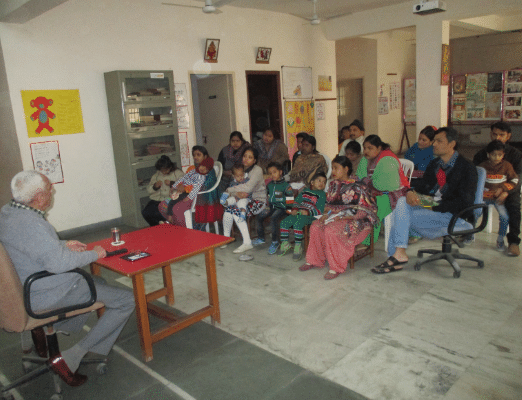
If you are a resident of Delhi-NCR, then it is important to know the laws for children rights in India and all the rules and regulations announced in the latest government orders with respect to the admission of disabled children in private and government schools in the region. Schools that are administered by the local government bodies will have similar orders pertaining to the specific areas. Please take advantage of the facilities provided by the government or your place of work in the choice of school.
Parents must choose the right schools for hearing impaired children that are within a short commute from the home so that the child does not have to waste time in travel. Also, it will be easier for the parents to visit the school on a weekly basis and engage with the teachers and other staff members. Parents must visit a few schools before deciding on one and ensure that their choice is based on a low teacher-student ratio. The language of instruction should be the same as what the child is being taught at Suniye and home. The schools for hearing impaired should have adequate medical facilities and a counselor who is trained in managing children with disabilities, especially hearing impairment.
It is important to meet the school principal and the teachers who will be part of the child’s education. Do not neglect to meet the physical education and arts & craft teachers, and the support staff. It is important to ensure that there is a good environment and a willingness to help before making a choice. If required, please feel free to take the assistance of the Suniye management committee and office bearers and even senior parents if you need help in deciding or need someone to come with you on school visits. It is always helpful if the hearing impaired child’s sibling is a student in the same school. Make sure that the teachers and staff are aware of this fact. It will be added benefit if someone among the friends and family are a member of the school.
Join Suniye today! Let your child learn to hear and speak with us.
